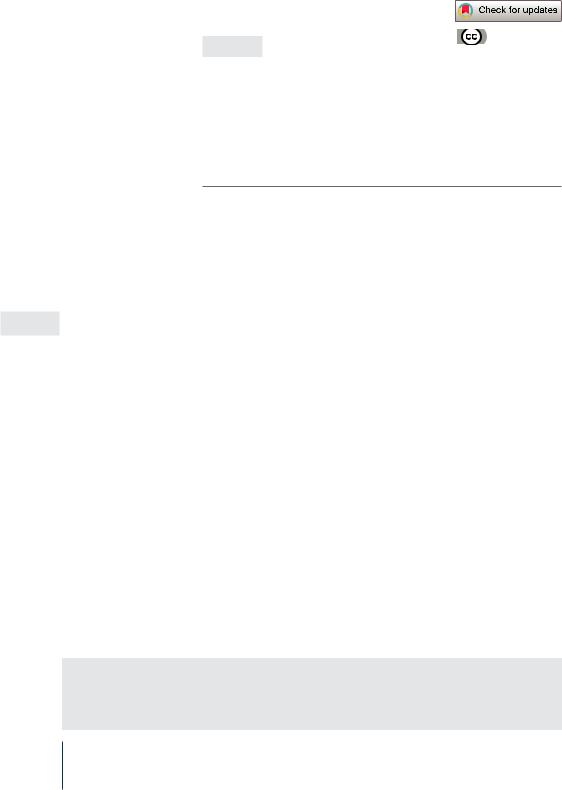
Том 2 № 1
.pdf
Digital Law Journal.Vol.2, No.1, 2021,p.29–47
BoQin,SuQi/DigitalTransformationofUrbanGovernanceinChina
Smart Economy
At present, 23 provincial-level regions in China have introduced top-level designs in the digital economy. With the core concept of “industry-city integration”, the construction of smart cities will help in promoting two-way data circulation between governments and enterprises, cultivating several leading digital service companies, and exploring a win-win pattern for urban transformation and industrial innovation. Overall, China’s digital industry is still led by the four major clusters of the Beijing-Tianjin-Hebei, Yangtze River Delta, Pearl River Delta, and Chengdu-Chongqing urban agglomerations.
Smart Governance
The development and innovative applications of the new generation of ICT have greatly improved social governance capabilities and promoted smart city governance methods that are more digital, networked, and intelligent. “Internet + supervision” has gradually developed into an effective meansofstrengtheningin-processandpost-eventsupervision.Manycitiesmakefulluseofbigdata and social credit systems to strengthen the tracking and early warning of market risks. For example, Beijing relies on the Enterprise Credit Information Network to list 200 000 enterprises in the list of business abnormalities, and uses big data technology to effectively control market supervision risks and to implement cross-department joint credit punishments on untrustworthy enterprises. In the field of urban security, Baidu is building an intelligent video surveillance platform for a smart city andsmartsecurity,providingfull-processservicesincludingcameraequipmentmanagement,video stream access, video frame extraction, video analysis, and alarm information display. The platform has the ability of surveilling helmet wearing compliance testing, work clothes compliance testing, fireworkstesting,strangerrecognition,smokingrecognition,andmobilephonerecognition.
Smart Ecology
Theconceptofgreensustainabledevelopmentisanimportantcomponentofsmartcities.Driven by technological innovation and the demand for sustainable development, many cities are actively exploring greener and lower-carbon production and lifestyles and promoting more precise ecological monitoring. The 5G integrated ecological detection system built by Xiong’an New Area utilizes the high speed and low latency of 5G, as well as the all-weather and all-terrain inspection features of drones and unmanned ships, to realize the ecological conditions and water quality monitoring of
Baiyangdian.Itsdataareinstantlyuploadedtotheplatformforanalysis,anditsupportsthestaffto observe the analysis results and on-site conditions through monitoring screens and virtual reality (VR)glasses.
Data Security
While the development of smart cities brings more convenient services to the public, the increased complexity of network platforms also simultaneously brings about the problem of digital space security. “Personal privacy protection” and “autonomy and trustworthiness” have become the focus of attention. The national level continues to increase the high-pressure supervision of data collection in violation of mobile application services. The Central Cyberspace Affairs Office is cooperating with the other four ministries to set up the “Special Task Force on App collection and use of personal information in violation of laws and regulations”. The Special Task Force aims to evaluate mobile applications in key areas, sort out the “blacklist” of illegal applications, and carry outsupervisionandrectificationwork.
40 ARTICLES

Цифровоеправо.Том2, №1, 2021, с.29–47
Б.Цинь,С.Ци/ЦифроваятрансформациягородскогоуправлениявКитае
Operation Models of a Smart City
Smart cities involve not only the evolution of the established concepts and the construction of infrastructure, but also the models of investment, operation management, and profit need, in order to enable the sustainable development of smart cities and to allow more people to benefit from them. In the process of developing a smart city, local governments have explored and developed somemodelstoclarifytherolesofgovernmentandenterprises.
Institutional Setting
The construction of smart cities is a systematic project involving a wide range of areas. Overall, specialized smart city management agencies in China are divided into two categories. The first one is the newly established Big Data Bureau, or other such specialized agencies which manage the construction of a smart city. At present, many cities have set up big data authorities with data resource management as the core function and are becoming the main institutions for data integration and sharing. According to our survey data, 277 cities across the country have established Big Data Bureaus or similar specialized agencies. The second one is the responsibility assumed by the Ministry of Industry and Informatization, the Development and Reform Commission, and the
Cyberspace Administration of China. Tianjin, Hebei, Liaoning, Shanghai, Jiangsu, Zhejiang, and some otherprovinceshaveassumedresponsibility.
Investment Models
Developing smart cities requires high levels of infrastructure and technological innovation, and a large amount of capital investment. From the perspective of operating funds, Wang et al. (2013) summarized the investment of smart cities into three models. First, the government independently invests in network construction and is responsible for maintenance. This model is mostly used in government affairs and some public service fields in which the main purpose is not to make profit. Second, the government takes the lead and is responsible for major investments, while the commissionsoperatorsproviderelevantsupportandobtainsomeparticularbenefitsorsubsidies.Thistype ofmodelgivesthegovernmenthigherregulatorycapabilities,buttheoperatorshavelittleinfluence on product planning and layout. Third, the government provides limited infrastructure and policy support, and operators are responsible for the main investment, construction, and operation (Wang et al., 2013). In the initial stage of the construction of smart cities in China, local telecom operators were the mainstay, and then the local government was gradually encouraged to cooperate with social capital. Some technology companies and social capital, such as Alibaba and Huawei, began participating.Theconstructionofsmartcitieshasevolvedfromasinglegovernment-ledmodeltoa diversifiedmodelofsocialparticipationandjointconstructionandoperation.
Operation Models
At present, among the 657 cities that carried out data monitoring, 433 (accounting for 65.91 %) have developed smart city projects with non-governmental agencies (firms and NGOs) acting as the main body. With the upgrading of a smart city, new operating models and the relationship between government and enterprises have emerged, giving rise to the role of “smart city operators” to coordinatetheconstruction,operation,andmanagementofsmartcities.
Smart city operators can be divided into two categories. The first is where the government and enterprises cooperate to establish specialized operating companies. This model could be described as“government-enterprisecooperation,theseparationofmanagementandoperation”,whichisthe
СТАТЬИ 41

Digital Law Journal.Vol.2, No.1, 2021,p.29–47
BoQin,SuQi/DigitalTransformationofUrbanGovernanceinChina
innovation of Guangdong’s “digital government” reform. The government departments took greater management responsibilities for analyzing needs and evaluating services. Tencent, China Mobile, China Unicom, and China Telecom jointly funded the Digital Guangdong Network Construction Co. Ltd., which assumed the operating responsibilities, including a series of tasks such as standard formulation, demand docking, data fusion, and system operation. The other category is to carry out the smart city initiatives that rely on large companies. In Zhejiang, Alibaba has proposed its being an in-depth partner not only for business cooperation but also for all aspects of planning, design, construction,andservices.
Profit Models
The construction and maintenance of smart cities require a large amount of capital investment, which is financially difficult for the government to bear. Therefore, the development of smart cities mustformaclearprofitmodeltoensuresustainability.
Atpresent,theprofitmodelofsmartcityprojectsismainlydividedintothreecategories.Thefirst is to accumulate users and monetize network flow. This entails accumulating many users through smart tourism, smart education, and other projects, and then providing value-added services to monetize network flow. For example, Tencent cooperated with the Puzhehei government in Yunnan
Province to build a smart scenic spot, relying on a large amount of tourist information to develop
“tourisminstallment”,“tourismloan”,andotherbusinessschemes.
The second is based on contract management and revenue sharing. For example, for a smart streetlight project invested by a company, the government will repay the saved electricity bills to the company in installments. When the contract management expires, the smart streetlight will be transferred to the government free of charge. This zero-government investment model effectively solves the problem of lack of funds and realizes the “three-win” situation of government saving money,socialenergysaving,andcorporateprofits.
The third is data desensitization and limited operation. The desensitized data is leased to an enterprise for further exploration of their potential commercial value. For example, in an Urban Smart Campus Project, the campus monitoring, campus surrounding monitoring, and school bus monitoring are integrated and opened to professional operating companies through the integrated urban operation platform. The operating companies can provide paid services to the government, schools, and parents, whilst allows parents to track their children’s activity through the application.
The Challenge Facing the Adoption of a “Smart City” Model
Smart cities are the product of technology and an urban development; in a short period, this has hugely influenced and nurtured many emerging businesses in China. Such rapid development will inevitably impact the original social legal order and pose unforeseen danger for the development of cities. Poor laws and regulations, similar / uniform / monotonous conceptions of smart cities, and isolatedinformationislandsaresomeofthechallengesthatshouldberesolvedinfuture.
Legal Challenges
The development of smart cities depends on the advancement of related technologies such as the Internet of Things, big data, and artificial intelligence. This has created a double-layered space between the networked society and the real society, which is characterized by the coexistence of
42 ARTICLES

Цифровоеправо.Том2, №1, 2021, с.29–47
Б.Цинь,С.Ци/ЦифроваятрансформациягородскогоуправлениявКитае
humans and machines (Changshan, 2018).Thisnewsocialorganizationhasprofoundlychangedlegal values,legalrelations,andlegalpractices.
In terms of legal practice, the current smart city construction mainly involves two legal issues: one for “people”, the other for “things”. Specifically, it includes the issue of the civil subject of the legal qualification of robots (Yujie, 2017), the copyright issue of works generated by artificial intelligence (Zhiwen, 2017), the tort law issue of human damage caused by intelligent systems (Handong, 2017), the personal rights issue of human data privacy protection (Wei, 2016),thetrafficlawissuesofintelligent driving systems (Xiao & Jianfeng, 2017), the labor law issues of machine “workers” (Handong, 2017),andsoon.TheseemergingissueshaveposedahugechallengeforChina’sexistinglegalsystem.
Firstly, existing legal norms are difficult to adjust and ineffectively cover legal interests. The development of smart interconnection has spawned many emerging things and businesses, such as smart contracts, virtual currencies, online shopping, ride-hailing, etc. These have formed an unprecedented relationship and fashioned a new framework of rights and obligations; for existing legal concepts, rules, and principles, this is difficult to effectively cover. Secondly, it is becoming increasinglydifficultforthistobeexplainedeffectivelybyChina’sexistingcivilandcommerciallaws, theories, and rules. In the context of a smart city, data resources have become important factors of production and social wealth. A series of platform companies, such as Tencent, Taobao, and JD, are constantly excavating and analyzing data to realize their own business interests. However, the nature, classification, ownership, usage rules, and legal responsibilities of data and information lacks explanatorypowerinthisregard.
In addition, various platforms, based on their business type and operational needs, have the right to self-regulate the marketing order of the platform themselves. The government has no time or ability to supervise the huge, ever-changing, and technical platform transactions. Instead, review management power has been granted to platforms in the form of laws, regulations, or rules.
They have the rights to formulate platform rules, penalize platform violations, and resolve platform disputes, which are the powers of quasi-legislation, quasi-enforcement, and quasi-judicial. This undoubtedly affects government intervention and market self-discipline, and the concepts, principles, and regulatory methods of administrative law have also encountered challenges (Changshan, 2018).
Finally, the existing judicial dispute resolution mechanism has also encountered obvious obstacles.Theintelligent,hierarchical,andfragmentedcharacteristicsofinternetcrimemakeitdifficultto adapt to the crime detection system based on traditional geographical and hierarchical jurisdiction. The detection rate of crimes such as cyber fraud is low, but the cost is high. Although China has establishedaninternetcourtinHangzhou,itlacksaclearlegalsystemandclearresponsibilities.There are still many issues that need to be resolved for the court in terms of jurisdiction, trial procedures, casetrials,andjudgmentenforcement.
Taking the China National Health Code as an example, the promotion of the health code has become a pioneering work in China’s epidemic prevention and control; however, it also runs personal information security risks. On the one hand, a large amount of sensitive personal information is concentrated under government control with the risk of personal information leakage; on the other hand, the handling of personal information lacks legal guidelines, and there are a large number of personal information processing activities that ignore the principle of informed consent and exceed the principle of minimum use and disclosure (Yuan, 2020).
In the field of data security, Europe and the United States have already conducted some legal explorations. The United States has passed the Consumer Privacy Bill of Rights Act of 2015 (CPBR), introduced a new scenario-led personal information protection mechanism, and taken the lead in
СТАТЬИ 43

Digital Law Journal.Vol.2, No.1, 2021,p.29–47
BoQin,SuQi/DigitalTransformationofUrbanGovernanceinChina
breaking through the current global structural model. The EU has added new mechanisms such as databreachnotification,privacyimpactassessment,andthird-partycertificationinitsdraft“General DataProtectionRegulation”(GDPR),highlightingnewconceptssuchasscenarioorientationandrisk assessment (Wei, 2016).
China implemented the Cyber Security Law in 2017, but it is not maneuverable enough, with less than a half of normative clauses (Qin, 2020). China still lacks clear legislation aiming at data privacy and security, and relevant regulations mainly rely on regulatory documents of government departments. At the national level, China has enacted “Guiding Opinions on Promoting the Healthy Development of Smart City”. At the same time, Shenzhen, Shanghai, Yinchuan, Tianjin, and other cities have also issued relevant documents on information security, which put forward requirements for data security management; nevertheless, their legal validity and enforcement binding have some limitations. At present, the relevant laws, regulations, systems, and policies in the field of smart citiesneedfurtherimprovementstopromotetheirsafe,healthy,andorderlydevelopment.
Commercial Challenges
Although the concept of a smart city has become the development model chosen by many, it is prudenttohighlightsomeofthecriticismsraisedagainstthisconcept.Thedefinitionofasmartcity has always been relatively vague, often associated with an intelligent, creative, and digital city. It regularly implies a relationship between technological progress and political, economic, and cultural changes. The hype of these terms is difficult to separate from the real practice, and eventually they are used more for the purpose of city marketing wherein some emerging cities are advertised as
“smartcities”(Hollands,2008).
These cities pay more attention to business-led urban development, hoping to use network infrastructure to improve economic and political efficiency and promote social, cultural, and urban development.However,theirfocusisonspecifichigh-techandcreativeindustries.Hollandsbelieves that a smart city has a technological determinism and capital dependence tendency to some degree but pays insufficient attention to people; at the same time, he also questioned the environmental sustainability of a smart city (2008). An important question is whether a smart city is truly environmentally friendly; the ICT revolution may not be as environmentally friendly as it initially seemed (Hollands, 2008). Even in some cities that truly practice the principles of a “smart city”, they have introduced specific technical parameters to distinguish between “good” and “bad” cities, leaving a new moral order for cities. Therefore, the discourse of a smart city may be a powerful tool for gene ratingdocilesubjectsandpoliticallegitimizationmechanisms(Vanolo,2013).
The construction of smart cities in China initially had obvious commercial tendencies. After a period of governmental guidance, companies still play a pivotal role. This confirms Hollands’ criticism ofasmartcity’scommercialorientation.Theresultisthatmanycitiesrushedintomassaction.China carriedout“smartcity”constructioninmorethan320 cities in 2012.Thelocalgovernmentsfollowed the experience of urban construction and formed path dependence, which restricts the innovation and development of cities. The practices and functions of every smart city are very similar, so effectivecomplementaryrelationshipscannotbeformedbetweencities(Shengzuetal.,2013).Duetothe lack of a reasonable top-level design, blindly following the trend has also led to the inadequate understandingofa“smartcity”insomecities.Theyeitheronlyemphasizetheinformatizationprojects, or include all kinds of irrelevant tasks into the scope of a smart city (Biyu et al., 2015). Besides, the technologicalorientationandcapital-dependencyofsmartcitieshaveformedaspatialaggregation
44 ARTICLES

Цифровоеправо.Том2, №1, 2021, с.29–47
Б.Цинь,С.Ци/ЦифроваятрансформациягородскогоуправлениявКитае
and imbalance. There is a clear gap in the construction level between the east and the west, and betweencitiesofdifferentlevels(Liying&Chao,2019).
Information Fragmentation Challenges
AsIBMsaid,asmartcitycanmakefulluseofICTtosense,analyze,andintegratevariousinformationinthecoresystemofcityoperation.11 Aftermorethantenyearsofdevelopment,China’scurrent smartcityprojectsstillfaceinformationislandsasthebiggestobstacletoresourceintegration.
At the technical level, the notion of a smart city covers many areas but currently lacks uniform guidingstandardsintermsofconstruction,operation,andevaluation.Theinterfacesbetweendifferentsystemsarecomplicated,whichmakesitdifficulttoachievesysteminterconnection,information sharing,andcoordination.Atthepracticallevel,althoughvariousdepartmentsinthecityhaveaccu- mulatedmassiveamountsofdataandinformationinthelong-terminformatizationapplication,the independenceandsegmentationofeachsystemandthelackofscientificandeffectiveinformation sharing mechanisms have led to many informatization islands. At the management level, it is difficult for urban departments to coordinate horizontally; administrative and managerial divisions are widespread.Somecollaborativeproblemsareoftentechnicallyeasytosolvebutpracticallydifficult toaddresswithinthemanagementsystems(Shengzuetal.,2013).
Conclusion
As a solution to urban problems, particularly after the 2008 economic crisis, the notion of a smart city has opened new development paths for cities. Relying on the sudden emergence of 5G, cloud computing, the Internet of Things, and other technical fields, China has made relatively outstandingprogressintheconstructionofsmartcities.Chinahasbuiltupmaturebasictechnical facilities and application platforms, and related technologies are widely used in the fields of eco nomy, governance, and general life. At the same time, results evaluation and sustainable models arealsoconstantlybeingexplored.Theseachievementshavebroughtgroundbreakingchangesto China’surbandevelopmentinthepastdecade.However,apartfromsuchachievements,thereare still barriers such as “information islands” in construction, technology, and management. These tremendous changes have also led to the criticisms of “labeling” and “urban marketing” being levelledatapartofso-calledsmartcities,whichhasbroughtnewchallengestoChina’seconomic, legal, and social orders.
In the future, China needs to further improve laws and regulations, build an integrated legal system, explore new regulation methods, shape a highly autonomous and refined governance order, promote effective law enforcement, justice, embed risk control institutional mechanisms, maintain a good legal order, and provide legal protection for the development of smart cities. At the same time, the supervision of smart cities should be strengthened through reasonable evaluationtoweakenthemarketingmotivationofsomecitiesusingthe“smartcity”modelasagimmick. In addition, further research in the fields of technology and management is needed to eliminate “information islands” and find a “smart city” development path that can realize resource integration and sharing.
11 |
CICRI, 2019. |
|
СТАТЬИ 45

Digital Law Journal.Vol.2, No.1, 2021,p.29–47
BoQin,SuQi/DigitalTransformationofUrbanGovernanceinChina
References:
1.Alawadhi, S., Aldama-Nalda, A., Chourabi, H., Gil-Garcia, J. R., Leung, S., Mellouli, S., Nam T., Pardo, T. A., SchollH. J., & Walker, S. (2012). Building understanding of smart city initiatives. In Scholl H.J., Janssen M., Wimmer M.A., Moe C.E., & Flak L.S. (Eds.), Lecture notes in computer science: Vol. 7443 LNCS. Electronic government (pp.40–53).Springer.https://doi.org/10.1007/978-3-642-33489-4_4
2.Biyu,W.,Junlan,L.,Weiru,Z.,Dong,J.,&Guoqiang,Z.(2015).Analysisonpracticeofsmartcitypilot.Modern Urban Research, 1, 2–6.https://doi.org/10.3969/j.issn.1009-6000.2015.01.001
3.Caragliu,A.,DelBo,C.,&Nijkamp,P.(2011).SmartcitiesinEurope.Journal of Urban Technology, 18(2), 65–82. https://doi.org/10.1080/10630732.2011.601117
4.Changshan, M. (2018). Legal changes in the era of the intelligent Internet. Chinese Journal of Law, 40(4), 20–38.http://www.faxueyanjiu.com/Magazine/Show?ID=69344
5.Deren,L.,Yuan,Y.,&Zhenfeng,S.(2014).Bigdatainsmartcity.Geomatics and Information Science of Wuhan University, 39(6), 631–640.https://www.cnki.net/kcms/doi/10.13203/j.whugis20140135.html
6.Wang,G.B., Lei,Z., & Honglei, L. (2013). Guo nei waizhihuicheng shililunyanjiu yu shi jiansi kao [Theore ticalresearchandpracticalconsiderationofsmartcityinChinaandabroad].Science & Technology Progress and Policy, 30(19), 153–160. http://caod.oriprobe.com/articles/40698520/guo_nei_wai_zhi_hui_cheng_shi_ li_lun_yan_jiu_yu_shi_jian_si_kao_.htm
7.Handong, W. (2017). Réngōng zhìnéng shídài de zhìdù ānpái yǔ fǎlǜ guīzhì [Institutional arrangement and legalregulationintheeraofartificialintelligence].Oriental Law, 5, 98.http://www.iolaw.org.cn/showNews. aspx?id=61404
8.Harrison,C.,Eckman,B.,Hamilton,R.,Hartswick,P.,Kalagnanam,J.,Paraszczak,J.,&Williams,P.(2010).Foundations for smarter cities. IBM Journal of Research and Development, 54(4), 1–16. https://doi.org/10.1147/ JRD.2010.2048257
9.Hollands,R.G.(2008).Willtherealsmartcitypleasestandup?City, 12(3), 303–320.https://doi.org/10.1080/
13604810802479126
10.Komninos,N.(2011).Intelligentcities:Variablegeometriesofspatialintelligence.Intelligent Buildings International, 3(3),172–188.https://doi.org/10.1080/17508975.2011.579339
11.Liying, Y., & Chao, Z. (2019). Zhōngguó zhìhuì chéngshì lǐlùn yánjiū zòngshù yǔ shíjiàn jìnzhǎn [A review of the theoretical research and practical progress of smart city in China]. E-Government, 1, 111–121. http://www.cnki.com.cn/Article/CJFDTotal-DZZW201901018.htm
12.Washburn, D., Sindhu, U., Balaouras, S., Dines, R. A., Hayes, N. M., & Nelson, L. E. (2010). Helping CIOs understandingsmartcityinitiatives:Definingthesmartcity,itsdrivers,andtheroleoftheCIO.Cambridge.
13.Marsal-Llacuna, M.-L., Colomer-Llinàs, J., & Meléndez-Frigola, J. (2015). Lessons in urban monitoring taken from sustainable and livable cities to better address the Smart Cities Initiative. Technological Forecasting and Social Change, 90(B),611–622.https://doi.org/10.1016/j.techfore.2014.01.012
14.Nam,T.,&Pardo,T.A.(2011).Conceptualizingsmartcitywithdimensionsoftechnology,people,andinstitutions.Proceedings of the 12th Annual International Conference on Digital Government Research Conference: Digital Government Innovation in Challenging Times, 282–291.https://doi.org/10.1145/2037556.2037602
15.Neirotti,P.,DeMarco,A.,Cagliano,A.C.,Mangano,G.,&Scorrano,F.(2014).Currenttrendsinsmartcityinitiatives:Somestylizedfacts.Cities, 38, 25–36.https://doi.org/10.1016/j.cities.2013.12.010
16.Qin, Z. (2020). Zhìhuì chéngshì zhìlǐ zhōng gèrén xìnxī de quányì jiěxī hé quánlì bǎohù [Rights and interests analysisandprotectionofpersonalinformationinthemanagementofsmartcities].Social Sciences in Nanjing,11, 93–97.https://kns.cnki.net/kcms/detail/detail.aspx?doi=10.15937/j.cnki.issn1001-8263.2020.11.013
46 ARTICLES

Цифровоеправо.Том2, №1, 2021, с.29–47
Б.Цинь,С.Ци/ЦифроваятрансформациягородскогоуправлениявКитае
17.Shengzu,G.,Jianwu,Y.,&Jiangri,L.(2013).Dāngqiánwǒguózhìhuìchéngshìjiànshèzhōngdewèntíyǔduìcè [Problems in the development of smart city in China and their solution]. China Soft Science Journal, 1, 6–12. https://doi.org/10.3969/j.issn.1002-9753.2013.01.002
18.Shengzu, G., & Min, W. (2012). Theoretical considerations and strategic choice on the development of smart city. China Population, Resources and Environment, 22(5), 74–80. https://doi.org10.3969j.issn1002-
2104.2012.05.013
19.Sisi, T., Yanqiang, Z., Zhiguang, S., Wei, W., & Yaqi, Z. (2020). Wǒguó xīnxíng zhìhuì chéngshì fāzhǎn xiànzhuàng, xíngshì yǔ zhèngcè jiànyì [Development status, situation and policy suggestions of China’s new smartcities].E-Government, 4, 70–80.https://doi.org/10.16582/j.cnki.dzzw.2020.04.007
20.Vanolo, A. (2013). Smartmentality: The smart city as disciplinary strategy. Urban Studies, 51(5), 883–898. https://doi.org/10.1177%2F0042098013494427
21.Wei, F. (2016). Reconstruction of the path of personal information protection in the era of big data. Global Law Review, 38(5), 92–115.https://doi.org/10.3969/j.issn.1009-6728.2016.05.007
22.Xiao, S., & Jianfeng, C. (2017). Lùn réngōng zhìnéng de mínshì zérèn: Yǐ zìdòng jiàshǐ qìchē hé zhìnéng jīqìrén wéi qiērù diǎn [Civil liability of artificial intelligence: A perspective on autonomous vehicles and intelligent robots]. Science of Law, 35. https://www.ixueshu.com/h5/document/e9d0c5b740fa830675b85bc-
07c8b6901318947a18e7f9386.html
23.Xibo,W.,&Zaigao,Y.(2010).Zhìhuìchéngshìlǐniànyǔwèiláichéngshìfāzhǎn[Theconceptofsmartcityand futurecitydevelopment].Urban Studies, 17(11),56–60.https://doi.org/10.3969/j.issn.1006-3862.2010.11.009
24.Yuan, N. (2020). Jiànkāng mǎ yùnyòng zhōng de gèrén xìnxī bǎohù guīzhì [Regulation of personal information protection in health code application]. Law Review, 38(6), 111–121. https://doi.org/10.13415/j.cnki. fxpl.2020.06.012
25.Yujie, Z. (2017). Lùn réngōng zhìnéng shídài de jīqìrén quánlì jí qí fēngxiǎn guīzhì [Robot rights and risk regulation in the age of artificial intelligence]. Oriental Law, 6, 56–66. http://iolaw.org.cn/showNews. aspx?id=62222
26.Zhiwen, L. (2017). Réngōng zhìnéng chuàngzuò wù de zhùzuòquán bǎohù wèntí yánjiū [Legal protection of artificial intelligence creations]. Science of Law, 35(5), 156–165. http://gb.oversea.cnki.net/KCMS/detail/detailall.aspx?filename=1018874939.nh&dbcode=CMFD&dbname=CMFDREF
Information about the authors:
BoQin*— Ph.D., Professor, Head of the Department of Urban Planning and Management, Renmin University of China,Beijing,People’sRepublicofChina.
qinbo@vip.sina.com
Su Qi — Master student, Department of Urban Planning and Management, Renmin University of China, Beijing, People’sRepublicofChina.
Сведенияобавторах:
ЦиньБ.* — Ph.D., профессор, заведующий кафедрой городского планирования и управления УниверситетаЖэньминь,Пекин,КитайскаяНародная Республика.
qinbo@vip.sina.com
ЦиС.— студентмагистратуры кафедры городского планирования и управления УниверситетаЖэньминь, Пекин,КитайскаяНародная Республика.
СТАТЬИ 47

https://doi.org/10.38044/2686-9136-2021-2-1-48-63
|
|
Articles |
4.0 |
|
|
|
DECENT WORK FOR DIGITAL
PLATFORM WORKERS.
A PRELIMINARY SURVEY IN BEIJING
Abstract
Yan Xu1,Dun Liu2,*
1SchoolofEconomicsandBusinessAdministration, BeijingNormalUniversity
19,Xinjiekouwaistr.,HaindianDistrict,Beijing,People’sRepublicof
China, 200044
2School of Economics and Management, China University of Labor Relations
45,Zengguangrd.,HaidianDistrict,Beijing,People’sRepublicofChina,100048
This paper discusses the status and implications of the employment relations and working conditions experienced by digital platform workers; the analysis is based on a survey conducted in 2017 on 1 338 workers engaged in work-on-demandviaapps(WODVA)from25 platformsinBeijing,ofwhom48.8%arefull-timeWODVAworkersor take WODVA as their primary job. The survey finds that nearly a half of the respondents engage in platform work duetoalackofemploymentopportunitiesinformallabormarketsortheirpermanentjobsprovidinginsufficient income. The respondents reveal substantial decent work deficits in representation, compensation, job stability, social protection, working time, and health and safety: 1)WODVA workers seldom have any voice in labor dispute settlements and have a very low rate of unionization; 2) about one third of the full-time WODVA workers cannot earn a living wage and 7.6 % of them earn less than the minimum wage level; 3) three quarters of the full-time WODVAworkershavenolaborcontractwiththeplatformsorotheremployers,noraccesstoemployer-contributed social insurances; 4)overtimeworkandunderemploymentcoexistamongfull-timerespondents,withnearly10% working for fewer than 4 hours per day while nearly 10 % work for more than 11 hours per day; 5) a majority of respondents run a higher risk of occupational health or physical risks, without any protection provided by the platforms or employers. To promote decent work by digital platform workers, the State needs to establish a portable social security system extending to all workers, to facilitate association and collective actions of platform workers either by extending the outreach of traditional unions or fostering new forms of organizations, to leverage digital technology to facilitate platform workers’ organization and information sharing, and even to promote universal
basicincomeandaworkers’cooperativeofplatformsinthelongrun.
Keywords
digitallaborplatform,platformworkers,work-on-demandviaapps,decentwork,workingconditions,labor market regulation
Conflictofinterest |
Theauthorsdeclarenoconflictofinterest. |
Financial disclosure |
The study is sponsored by the National Social Science Foundation of China |
|
(grantnumber:16CJL036). |
48

Acknowledgments |
The authors deeply appreciate Beijing Municipal Federation of Trade Unions |
|
(BMFTU) for their providing access to the datasets. The authors also express sin- |
|
cere gratitude to Professor Vladimir S. Osipov of the Moscow State Institute of |
|
InternationalRelationsforhisselflesshelpinimprovementsandthepublication |
|
of this article, along with other related scholars in Russia involved in cooperation |
|
with Beijing Jiaotong University under the grant of graduate education reform |
|
project of Beijing Jiaotong University “China-Russia Comparative Research in the |
|
DevelopmentofLaborEconomicsDiscipline”(grantnumber:134575522). |
For citation |
Xu,Y.,&Liu,D.(2021).Decentworkforthedigitalplatformworkers.Apreliminary |
|
survey in Beijing. Digital Law Journal, 2(1), 48–63. https://doi.org/10.38044/2686- |
|
9136-2021-2-1-48-63 |
* Corresponding author |
|
Submitted: 24 Nov.2020, accepted: 26 Jan.2021, published: 31Mar.2021
Статьи
ОБЕСПЕЧЕНИЕ УСЛОВИЙ И ОХРАНЫ ТРУДА РАБОТНИКОВ IT-ПЛАТФОРМ В ПЕКИНЕ
Я.Сюй1,Д.Лю2,*
1Школа экономикииделовогоадминистрирования, Пекинскийпедагогическийуниверситет 200044,КитайскаяНародная Республика,Пекин,районХайдянь, ул.Синьцзекоувай,19
2Школаэкономикиименеджмента,Китайскийуниверситет трудовыхотношений 100048,КитайскаяНародная Республика,Пекин,районХайдянь,
ш.Чжэнъян,45
Аннотация
В статье обсуждаются условиятруда работников цифровых платформ. Опрос 1 338 респондентов, занятых работой на 25 Интернет-платформах в Пекине (work-on-demand via apps, WODVA), показал, что почти половина из них работают на IT-платформах из-за отсутствия возможноститрудоустройства на традиционном рынкетруда или недостаточной заработной платы на основной работе. Респонденты отметили проблемы,связанныесневозможностьюучастиявдеятельностипрофсоюзов,недостаточнойзаработной платой, отсутствием стабильности, социальной защищенности, а также проблемы регламентации рабочеговремени,охранытрудаитехникибезопасности,аименно:1)отсутствуетэффективныймеханизмразре- шениятрудовыхспоровиз-занедостаточной развитостипрофсоюзныхорганизаций;2)заработнаяплата около 1/3 опрошенных WODVA ниже прожиточногоминимума, а 7,6 % — меньшеминимального размера оплатытруда; 3) 3/4 работников WODVA, занятых полный рабочий день, не имеюттрудового договора
49
